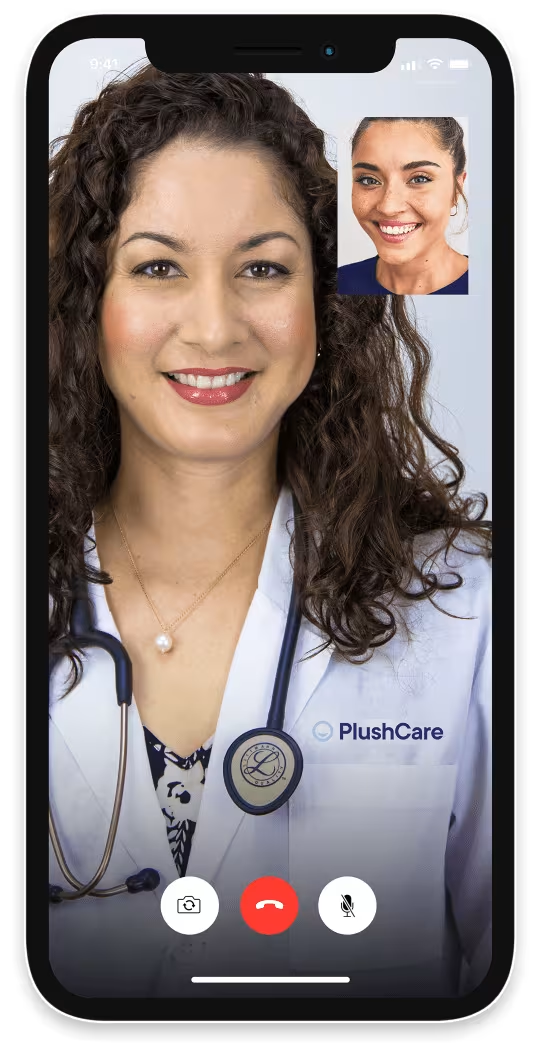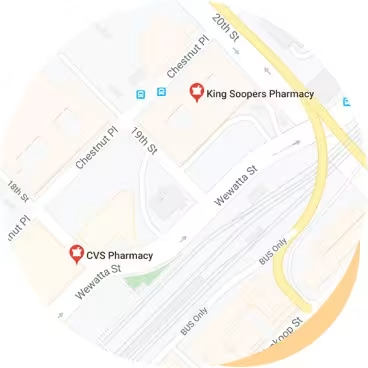- Chronic Care
Migraine
Online migraine treatment - get prescription migraine meds today*
In order to treat your migraines, consult with one of our board-certified primary care doctors online today to prescribe medications to get relief from migraines. Get a new prescription to treat migraines or refill an existing prescription today.*
Book an appointmentExpert guidance for managing migraine triggers
Virtual consultations for migraine management
Individualized treatment plans for migraine relief
*Prescriptions are provided at the doctor's discretion. Plushcare does not employ neurologists at this time. Learn more about our controlled substances policy and how to save up to 80% with our prescription discount card. PlushCare doctors cannot treat all cases of migraines. Our primary care physicians can conduct an initial evaluation of your symptoms but may need to refer you to a specialist or for in-person treatment. If you are experiencing life-threatening symptoms, seek emergency medical attention immediately.

Learn about migraines
Migraines are a common neurological disease that can cause intense headache, often with sensitivity to light and nausea. In addition, migraines are a recurring type of headache of varying severity. For some people, migraine attacks may be so debilitating that they can't go about their normal day-to-day activities.
Migraine causes
Currently, exact causes of migraine headaches are an area of active research. However, researchers have found that several factors, such as genetics and the environment, seem to play a role.
There are a variety of different factors that can trigger migraines. For some people, certain foods or drinks (e.g. alcohol) can trigger migraine headaches. Other common triggers of migraine attacks include stress, lack of sleep, bright lights, and strong smells. If you suffer from headaches, it's important to keep track of your triggers so you can avoid them in the future.
Some key migraine headaches triggers include:Emotional: Anxiety, stress
Physical: Overexertion or lack of exercise
Hormonal: Hormonal changes in women during certain life stages
Environmental: Sudden shift in living environment (maybe related to stress)
Dietary: An unhealthy diet, skipping meals, caffeine or alcohol
Medicines: Overdependence on migraine medication
Symptoms of migraines
From mild to severe migraine symptoms can vary between people and also between headaches. The most common acute symptoms of migraines include throbbing or pulsing pains in the head. The pains are usually on one side of the head but can be anywhere else on the head and face. This acute pain can be moderate to severe. Other symptoms include:
Depression
Dizziness
Fever
Loss of appetite
Nausea and vomiting
Sensitivity to light, noise, and/or smells
Tenderness in the temples or neck
Some people also experience an aura before a migraine. An aura is an acute warning sign that a headache is about to start. It can include visual disturbances, such as flashes of light or wavy lines. Migraine frequency also varies from person to person.

How to treat migraines
There are many ways that you can treat your migraines, and the best way depends on what is triggering your headaches.
If you know what is causing your migraines, you can try to avoid those triggers. However, keep in mind that there is no cure for migraines, and you will likely need to use a combination of treatments to find relief.
For the medicinal approach, your doctor will typically recommend medicines from either of the two categories:
Pain relieving medications: These include medicine taken during the migraine to help with pain relief, also known as rescue or abortive treatment.
Preventive medications: These are used to try to prevent migraines from starting or occurring as often. They are taken on a regular basis, even when you don’t have a migraine. These medicines should be taken daily and are usually indicated when you have a certain number of migraines per month.
Home remedies and alternative treatment plans
In addition to medication, here are some home remedies you can try that may help:
Relaxation techniques: Yoga and meditation can help to reduce stress, which can trigger migraines. Mental health management is important for many people with migraines.
Sleeping in a dark quiet room
Biofeedback: This is a technique that uses sensors to measure things like heart rate and muscle tension. This information is then used to help the person learn to control their body in a way that reduces pain.
Migraine medications
There are a variety of migraine medications available to help provide migraine relief. Some of these medications are over-the-counter (OTC), while others require a prescription from your doctor.
OTC Medications
Pain relief medicine: There is a variety of pain relief medicine that you can take for your migraines, and the best one for you will depend on the severity of your migraines. If you have mild migraines, over-the-counter painkillers called NSAIDs, such as ibuprofen or aspirin, can be effective. Excedrin (aspirin, acetaminophen, caffeine) can work slightly better but should be avoided if you have a caffeine intolerance. However, if you have severe migraines, you may need to take prescription-strength painkillers.
Anti nausea medication: If you are suffering from nausea as a result of your migraines, there are a variety of anti-nausea medications that you can take. These medications can help to reduce the amount of vomiting, and they can also help to make you feel more comfortable. can help if you are experiencing nausea and vomiting.
Prescription medications
If you find your current OTC medicine ineffective, talk to your doctor about getting prescription medications.
Triptans: These are specifically designed to treat migraines. They work by narrowing the blood vessels around the brain, and they can also help to reduce the inflammation that is associated with migraines. They can be taken as a pill, nasal spray, or injection. Brand names include Imitrex and Maxalt.
Calcitonin gene-related peptide (CGRP) agonists: These medicines may work better than triptans to stop a migraine as it’s happening, and also may be helpful for people who can’t take triptans due to side effects or contraindications. Brand names include Nurtec. Other brand names like Aimovig are injections that can prevent migraines for long periods, but are only available by neurologists. Our primary care doctors can help refer you to neurology to be evaluated for these types of treatments.
Beta blockers: Examples include propranolol, atenolol and nadolol. These work well as preventative medicines.
Anti-seizure drugs: Examples include topiramate and valproic acid. These work well as preventative medicines.
Antidepressants: Some individuals may also explore the option of antidepressants online as part of their prescribed migraine management strategy, which can work well as preventatives.

How to prevent a migraine
There are a few things you can do to avoid migraines. First, pay attention to your triggers and try to avoid them. Common triggers include stress, bright lights, strong smells, and certain foods.
If you can't avoid all of your triggers, try to manage them with relaxation techniques or medications. Second, eat a healthy diet and get enough sleep. Third, exercise regularly. Exercise can help reduce stress and improve your overall health. Fourth, if you're a woman, pay attention to your hormone levels.
Hormonal changes can trigger migraines, so talk to your doctor about birth control options or other medications that can help stabilize your hormones.

When to see a doctor for migraines
If you experience any of the following during migraines, it is important to see a medical professional immediately:
Fever, stiff neck, or vomiting
Changes in your vision
Weakness or numbness in your face or body
In addition, if you experience the following:
You have never had a migraine before and are over the age of 50
Headaches that appear after suffering from a head injury
Migraines that come on abruptly
Migraines that prevent you from functioning normally despite medication
If you experience any of the above, it is important to see a doctor as soon as possible. Migraines can be a sign of a more serious underlying condition, and it is important to rule out any potential causes.
Your doctor can perform the following to get an accurate diagnosis:
Take note of your symptoms
Evaluate your medical history
Perform physical and neurological examinations
Migraine treatment FAQs
How do you get rid of a migraine fast?
There is no one answer to this question, as different people respond to different treatments.
However, some common migraine treatments include over-the-counter pain relievers, such as ibuprofen or acetaminophen; prescription medications, such as triptans; and lifestyle changes, such as getting regular exercise and managing stress.
You may be able to get rid of a migraine fast by seeing a doctor online without having to leave home. An online doctor like our board-certified primary care physicians may be able to confirm your migraine diagnosis, rule out other conditions, and give you a personalized treatment plan, including prescription medications not classified as controlled substances.They can also help set you up with a specialist like a neurologist in-person if they feel that telehealth is not the best or safest treatment for you.What are the symptoms of a migraine?
The most common symptom of a migraine is throbbing or pulsing pain on one side of the head. Other symptoms may include nausea, vomiting, sensitivity to light and sound, and dizziness or vertigo.
Some people also experience aura symptoms prior to their migraines, such as seeing flashes of light or experiencing temporary blindness.
3 simple steps to get treated for migraines online

Step 1
Book a migraine treatment online appointment.
Book a same day appointment from anywhere.

Step 2
Talk to your medical provider regarding your migraine symptoms.
Visit with a doctor on your smartphone or computer.

Step 3
Pick up a prescription for migraines.
We can send prescriptions to any local pharmacy.
Related conditions to migraines
Depression
Fibromyalgia
Heart Disease
High Blood Pressure
Pregnancy
PTSD
Seizure
Sleep Disorders
Stroke
Migraine treatment pricing details
How pricing works
To request migraine treatment and get a new prescription or refill on your prescription, join our monthly membership and get discounted visits.
Paying with insurance
Membership
$16.99/month
First month free
Visits
Copay
30 days of free membership
Same-day appointments 7 days a week
Unlimited messages with your Care Team
Prescription discount card to save up to 80%
Exclusive discounts on lab tests
Free memberships for your family
Cancel anytime
Visit price with insurance
Often the same as an office visit. Most patients with in-network insurance pay $30 or less!
We accept these insurance plans and many more:
Paying without insurance
Membership
$16.99/month
First month free
Visits
$129
30 days of free membership
Same-day appointments 7 days a week
Unlimited messages with your Care Team
Prescription discount card to save up to 80%
Exclusive discounts on lab tests
Free memberships for your family
Cancel anytime
Visit price without insurance
Initial visits are $129.
If we're unable to treat you, we'll provide a full refund.
Frequent Urgent Care Searches
- Scopolamine patches Urgent care for pneumonia Zofran Prescription nausea medication Tessalon perles Prednisone Asthma inhaler prescription Pediatric care Medrol (methylprednisolone) Constulose (lactulose) Cough Treatment Online Food poisoning treatments Gastritis treatment Linzess (linaclotide) Nurtec (rimegepant) Vistaril
Migraine treatment resources
Sources:
PlushCare is dedicated to providing you with accurate and trustworthy health information
Mayo Clinic. “Migraine.” Mayo Clinic, Mayo Foundation for Medical Education and Research, Accessed October 12, 2023, https://www.mayoclinic.org/diseases-conditions/migraine-headache/symptoms-causes/syc-20360201
American Academy of Family Physicians. “Treatment of Acute Migraine Headache.” American Family Physician, vol. 97, no. 4, 2018, pp. 243–251. Accessed October 12, 2023, https://www.aafp.org/pubs/afp/issues/2018/0215/p243.html
NHS. “Migraine.” NHS, Accessed October 12, 2023, https://www.nhs.uk/conditions/migraine/
PlushCare content is reviewed by MDs, PhDs, NPs, nutritionists, and other healthcare professionals. Learn more about our editorial standards and meet the medical team. The PlushCare site or any linked materials are not intended and should not be construed as medical advice, nor is the information a substitute for professional medical expertise or treatment.